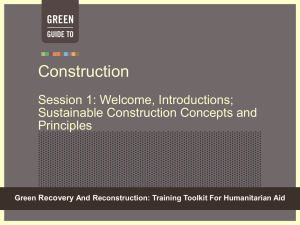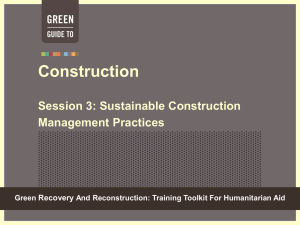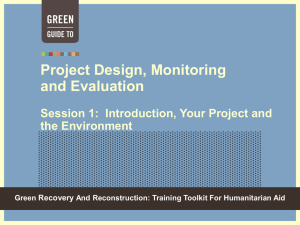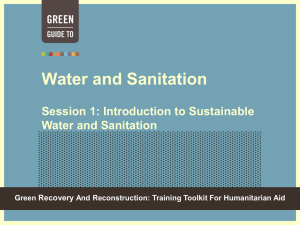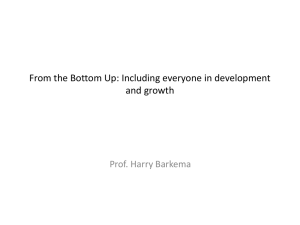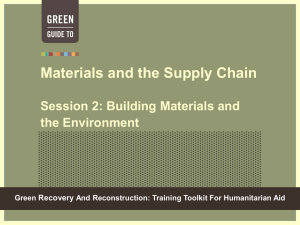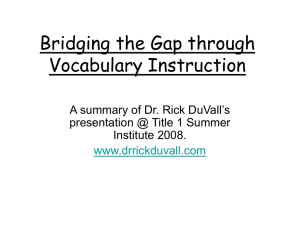Module 6 Session 2 - Green Recovery & Reconstruction
advertisement
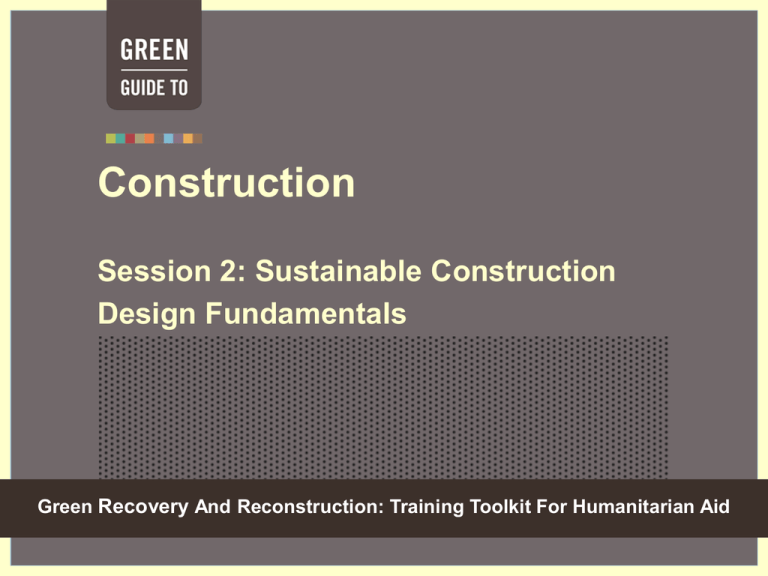
Construction Session 2: Sustainable Construction Design Fundamentals Green Recovery And Reconstruction: Training Toolkit For Humanitarian Aid In this session we will discuss… Key challenges of sustainable construction The concept of the “Green Baton” The importance and value of several fundamental sustainable construction design concepts How to use these fundamental design concepts to analyze and recommend solutions to several sustainable construction case study challenges Mod 6 Ses 2 2 Key Challenges Lack of understanding of ecological impact of construction activities Lack of early rapid environmental assessment Use of hazardous materials Special interests who don’t prioritize sustainable construction Disregard for the local population Poor planning by project managers Others? How is sustainable construction impacted by these challenges? (write 1 challenge per card) Mod 6 Ses 2 3 The “Green Baton” Concept Briefing Design Detail Design Prod’n Info Tender Action Site Options Handover And O + M More Sustainable Less Sustainable Client Design Team Contractor Affected Population ‘The Green Baton may be dropped at key points in the process…Once dropped, it is difficult to pick up again and regain lost ground.’ Howard Liddell Mod 6 Ses 2 4 Picking Up the Baton What experience do you have for the baton being dropped? When & How? What might be the reasons at different stages of construction that some stakeholders may drop the green baton? How can we pick up the baton? Or not let it fall? What actions are needed at different stages taken by different stakeholders? Mod 6 Ses 2 5 Design Challenges & Solutions Choice of Materials “ The choice of materials can impact the host community, the environment and future maintenance needs...” How? Mod 6 Ses 2 6 Impacts of Material Choices Extraction, mining, harvesting Environmental impact? Processing and production Environmental impact? Transportation & distribution Environmental impact? Packaging Environmental impact? Building Environmental impact? Disposal Environmental impact? The project manager must weigh the potential impacts at each stage Mod 6 Ses 2 7 Design Challenges & Solutions Use of Existing Materials In the workshop Materials and the Supply Chain we discussed the 3-Rs: Reduce, Reuse, Recycle With this workshop, on the topic of construction, we go deeper and discuss Reduce Reuse Recycle Refuse (to build) Repair Recover (energy) Mod 6 Ses 2 8 Berge’s Cycle of Materials Ore, stone, clay, Oil, timber, plants, etc. Mining, Drilling, harvesting Ore Primary refining process Metals, chemicals, cement, fired Clay , fibre, sawn timber, etc. Recycle Secondary refining process Reuse Structural materials, climatic materials, surface materials Building process Oil Timber Building The Earth Mod 6 Ses 2 Dumping Waste Use 9 Design Challenges & Solutions Sourcing & Procurement Support legal and sustainable practices Minimize packaging in procurement of materials Purchase materials locally when practical Do no harm concept: environmental and economic impact Mod 6 Ses 2 10 10 Challenge Illegally cut lumber in Brazil Mod 6 Ses 2 vs. Solution Wood certified as harvested responsibly 11 Design Challenges & Solutions Energy & Climate Concerns Solar orientation Energy efficiency, insulation, ventilation, etc. Climate type: hot/dry, hot/humid, or cold Summer Winter South Mod 6 Ses 2 North 12 Design Challenges & Solutions Water & Wastewater Challenge Mod 6 Ses 2 Recycling of grey water Septic tanks Treatment wetlands 13 13 Photo credit: Manoocher Deghati/IRIN One Solution: Treatment Wetland Janakaraj Murali - Constructed Wetlands in Phang Nga, Thailand Mod 6 Ses 2 14 Design Challenges & Solutions Getting local community acceptance Community participation Knowledge sharing Analysis of existing, traditional practices Mod 6 Ses 2 Photo by David Gazashvili, CARE Int’l 15 Design Challenges & Solutions Existing, traditional practices Traditional construction techniques Use local skills & materials; can be implemented faster, to higher standard Space use norms defined by culture & function; can dictate use of building: fully used, partially used, sold, or abandoned External space use norms should be considered (e.g. outdoor cooking in hot dry climates Religious, other beliefs can affect construction (e.g. direction a building and/or its entrances must face) Mod 6 Ses 2 16 Design Failure This proposed shelter is said to be earth-friendly, non-toxic and can be assembled easily and quickly in disaster area. BUT, it doesn’t meet basic human needs. vs. Success School built in Maldives after tsunami http://www.iaacblog.com/AAC2007-finalists/wpcontent/uploads/2008/02/42cdb3panel3_1.jpg Mod 6 Ses 2 17 Case Study: Kenya Floods Photo credit: Richard Lough/IRIN Key challenges confronting: • the affected? • the Government? • the international community? Current priorities? Solutions to minimize environmental impact and to provide for positive and sustainable reconstruction outcomes for the affected population ? Mod 6 Ses 2 18 18 Case Study: Pakistan Earthquake Key challenges confronting: • the affected? •the Government? • the international community? Current priorities? Solutions to minimize environmental impact and to provide for positive and sustainable reconstruction outcomes for the affected population ? Mod 6 Ses 2 Photo credit: Edward Parsons/IRIN 19 19 Case Study: Sri Lanka Tsunami Photo credit: WFP/Jordan Dey Key challenges confronting: • the affected? • the Government? • the international community? Current priorities? Solutions to minimize environmental impact and to provide for positive and sustainable reconstruction outcomes for the affected population ? Mod 6 Ses 2 20 Case Study: Peru Earthquake Photo credit: USGS Key challenges confronting: • the affected? • the Government? • the international community? Current priorities? Solutions to minimize environmental impact and to provide for positive and sustainable reconstruction outcomes for the affected population ? Mod 6 Ses 2 21 21 Case Study Reports Key challenges confronting: the affected? the Government? the international community? Current priorities? Solutions to minimize environmental impact and to provide for long-term sustainable reconstruction? Mod 6 Ses 2 22 More about Construction after Lunch Mod 6 Ses 2 23
